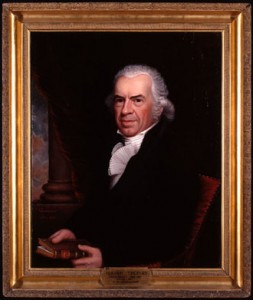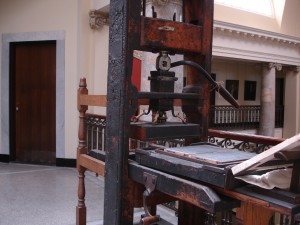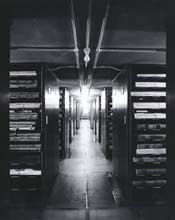Did you know that a patriot printer named Isaiah Thomas founded the American Antiquarian Society in 1812? Did you know that the terms uppercase, lowercase, and stereotype originated from terms used in relation to early printing presses? Did you know that early printers needed to read backwards and upside down? Do you  know why the pages of many late nineteenth-century books crumble when turned? The answers to all of your unasked questions about Isaiah Thomas, early printing, the American Antiquarian Society’s history, and more can be learned on the library’s free public tours offered every Wednesday afternoon at 3:00pm.
know why the pages of many late nineteenth-century books crumble when turned? The answers to all of your unasked questions about Isaiah Thomas, early printing, the American Antiquarian Society’s history, and more can be learned on the library’s free public tours offered every Wednesday afternoon at 3:00pm.
As a new intern here in the readers services department, I joined Elizabeth Pope, Head of Reader Services, last Thursday for a fascinating tour of the library. I thought I would blog about what I learned for the benefit of the readers of Past is Present who are as curious as I was about the library’s history. The tour was specially arranged for a local college history professor and his class of what we hoped were budding young historians. Beginning the tour in the lobby, Elizabeth showed us the portrait of Isaiah Thomas, which hangs above the stairs, informing us that he was a patriot printer who lived during the Revolutionary War. She then led us upstairs to see Isaiah Thomas’s original wooden printing press and the shoulder-height cases where he stored his type.
Standing amid Isaiah’s printing equipment on a landing overlooking the reading room, Elizabeth regaled us with engaging historical facts. Isaiah Thomas’s press was a wooden one, made in England, and it had a name. Isaiah referred to it as “Old No. 1.” Born into a poor family, Isaiah was apprenticed to a printer at a young age. Elizabeth explained to us that it was a common phenomenon in early America  to apprentice young boys to a tradesman. Can you imagine what it would be like to leave your family at the age of eight and be required to learn a trade? Isaiah later became such a successful printer that he was able to buy his master’s business, including the very printing press that Isaiah had first learned on as a young apprentice, something that Elizabeth surmised must have brought him satisfaction. Isaiah called this press “Old No. 1” as it was the first of many in what became his printing empire.
to apprentice young boys to a tradesman. Can you imagine what it would be like to leave your family at the age of eight and be required to learn a trade? Isaiah later became such a successful printer that he was able to buy his master’s business, including the very printing press that Isaiah had first learned on as a young apprentice, something that Elizabeth surmised must have brought him satisfaction. Isaiah called this press “Old No. 1” as it was the first of many in what became his printing empire.
Isaiah Thomas was famous for publishing, The Massachusetts Spy, a Whig newspaper, which supported the cause of American Independence. One day in April 1775, just days before the Battle of Lexington, Thomas heard rumors that the British were intending to seize his press. He smuggled it out of Boston and set it up in Worcester where he published accounts of the Battles of Lexington and Concord. Years later, in the hopes of improving posterity, he later founded the American Antiquarian Society also in Worcester, donating his personal collection of over 8,000 books to the library.
Watch a dramatic re-enactment of Isaiah Thomas, The Patriot Printer, from the American Antiquarian Society on Vimeo.
Elizabeth passed around a facsimile of the first paper printed in Worcester on Isaiah’s press and showed us the metal type letters similar to the type Isaiah Thomas used in printing. In the eighteenth-century, type was stored in separate cases; the lowercase was nearest to the printer’s apprentice who would be setting the type and it contained the more frequently used smaller letters, which would come to be called lowercase. The farther case had the larger capital letters, which would be come to be called uppercase. Elizabeth showed us a composing stick, a small tray that could fit a couple lines of type, that was used to move the type over to the composing stone, where each page worth of type was set into a metal tray. Basically, you needed to be able to read backwards and upside down in order to lay the type since it needed to have a reverse impression when pressed onto paper! Later in the early nineteenth century when printers devised paged-sized metal molds of type, used to print a whole sheet at the same time, it was called a stereotype – the root of our term, stereotype, or a pre-prepared, conventional notion. Elizabeth also showed us how to work the press and informed us that printers in early America could be identified when walking down the street in Boston since they had overly developed muscles on the arm they used to pull the bar on the press. Apparently printing was the early American counterpart to scooping ice cream at Ben and Jerry’s, only more extreme!
 The tour resumed in the closed stacks where the Society stores all its collection materials. On the floor we were on, shelves of large, flat boxes filled with newspapers lined the walls in a room where lights are dim for preservation purposes. Elizabeth passed around a duplicate copy of The Boston Chronicle, an early eighteenth-century newspaper printed on paper with a high rag content. She informed us that the earliest newspapers were made from rags. In fact, newspapers often put out ads asking for people’s old white rags to make their papers. This paper is easier for librarians to preserve than later paper since its fibers are relatively strong. Later paper was made from wood pulp. Brittle, yellow, and easily crumbled when handled, the pages of many late nineteenth-century books were made from wood pulp. The next time you read an early copy of The Adventures of Huckleberry Finn, you’ll know why it’s crumbling in your hands! Elizabeth proceeded to show us the newest, state-of-the-art part of the stacks where rare books and pamphlets are stored.
The tour resumed in the closed stacks where the Society stores all its collection materials. On the floor we were on, shelves of large, flat boxes filled with newspapers lined the walls in a room where lights are dim for preservation purposes. Elizabeth passed around a duplicate copy of The Boston Chronicle, an early eighteenth-century newspaper printed on paper with a high rag content. She informed us that the earliest newspapers were made from rags. In fact, newspapers often put out ads asking for people’s old white rags to make their papers. This paper is easier for librarians to preserve than later paper since its fibers are relatively strong. Later paper was made from wood pulp. Brittle, yellow, and easily crumbled when handled, the pages of many late nineteenth-century books were made from wood pulp. The next time you read an early copy of The Adventures of Huckleberry Finn, you’ll know why it’s crumbling in your hands! Elizabeth proceeded to show us the newest, state-of-the-art part of the stacks where rare books and pamphlets are stored.
This special tour ended in the council room, a large room with a long table where curators laid out rare books and manuscripts for the students to see relating to the Civil War. (On the normal public tour you get to see the council room, but these original materials would not be out.) Plastic book cradles supported the bindings of many of the old books. We were excited to learn that visitors are allowed to gently touch original documents at the American Antiquarian Society, as long as their hands are clean and dry. A curator led us around the room and showed us each book or manuscript. The first was a large sheet of paper describing slaves for sale. Others were Civil War sheet music and a document outlining the conditions of surrender for the seceded states. Among the treasures on display were children’s books printed in the North and South during the war and a printed story about a woman who lived in a cave during the Battle of Vicksburg. Seeing these original documents, and being allowed to lightly handle them, brought history alive.
Elizabeth informed us that the American Antiquarian Society estimates they have two out of every three books printed before 1820 in what became the United States, which makes it the best collection of such material in the world. AAS continues to collect original sources and recent works on early America through 1876, actively acquiring additional material every day. She invited the tour to come back to the American Antiquarian Society to conduct research. If you have a research project related to early America before 1876 (or even 1900), it only takes about half an hour and two forms of ID (one with a photograph) to register to use the resources at AAS. The research library is not appropriate for children, but high school students may do advanced research here if accompanied by a parent. More information about the requirements and the process of registering as a reader (the term for library patrons in rare book libraries) is on the “Using the Library” page on the AAS website.
So the next time have a historical research project or are investigating your family tree or the history of your hometown, make researching in the reading room here at the American Antiquarian Society a part of your afternoon. Or if you’re simply curious about early American history and old books, join us at 185 Salisbury Street, Worcester, MA for a tour any Wednesday at 3:00pm.
